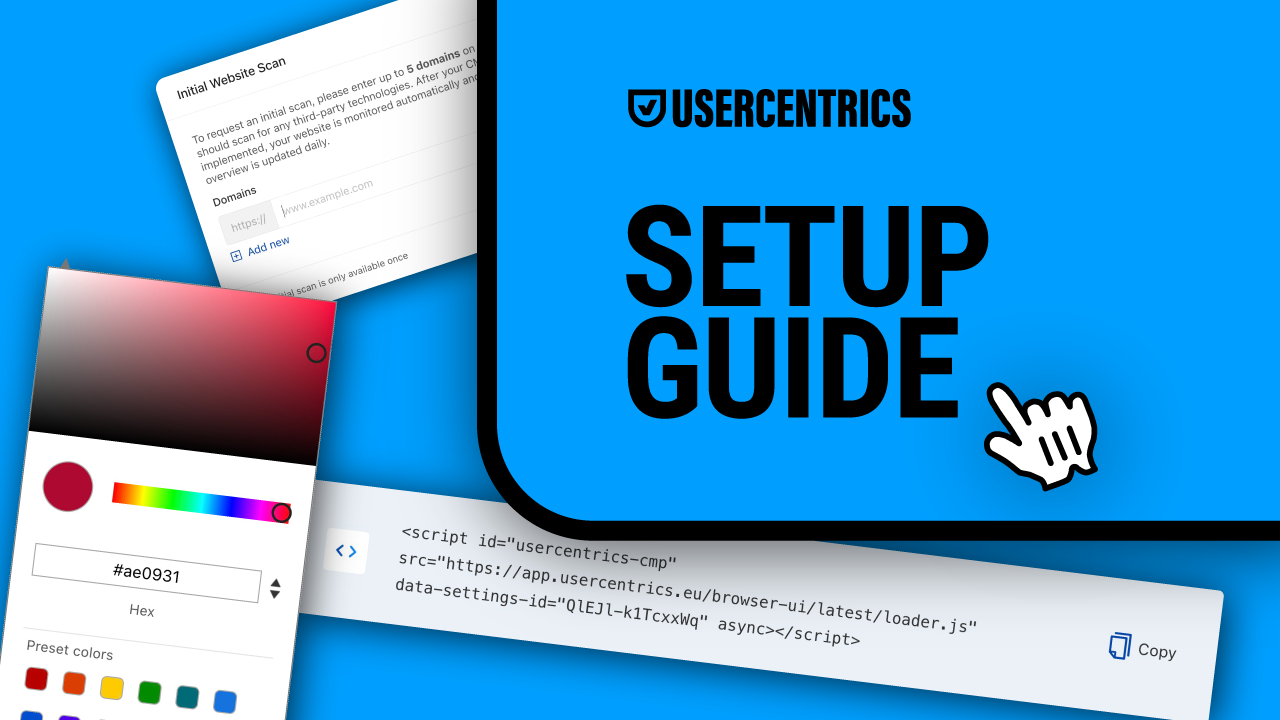You have budget allocation, you have messaging and graphics, and you’re ready to pull the trigger on a great targeted marketing campaign. But wait, are you forgetting something critical? Are you getting the right consent from your audience?
Major ad platforms like Google Ads require obtaining and signaling user consent for you to maintain full access to all their features, including personalization and targeted advertising. Don’t risk wasting thousands of dollars of your ad budget and scrapping that remarketing campaign by failing to get consent.
Usercentrics Audience Unlocker is the answer. It enables digital marketers to obtain valid user consent that can be seamlessly signaled to the ad platforms you rely on. So you can continue to leverage Google Customer Match and enhanced conversions, and will soon also include LinkedIn custom audiences, Meta custom audiences, and other re-engagement tools.
Read on to learn how you can seamlessly obtain and sync consented first-party data to fully leverage retargeting while staying compliant with privacy regulations and building trust and engagement with your audience.
What is Audience Unlocker and why do you need it?
Audience Unlocker is a lightweight, focused solution that simplifies consent management for digital marketing. It delivers secure data capture and directly integrates with Google Ads so you can seamlessly obtain consent from users and sync valuable first-party data with your marketing tools.
Zero-party and first-party data are valuable because they come directly from customers and website visitors. Zero-party data is provided voluntarily, e.g. through surveys, feedback forms, or review, or account settings and preferences. First-party data is collected by your company via website analytics of user activities, customers’ purchase records, email and social analytics, and other sources. As this data directly reflects user actions, it helps enable better predictive analysis and segmentation, among other functions. Explicit user consent is increasingly required to process first party data, but it’s easy to provide clear information about the use and value for customers.

The Digital Markets Act (DMA) also brought strict consent requirements to big tech platforms. To achieve and maintain compliance, those gatekeeper companies, including Google, have put in place their own requirements for their customers, affecting millions of companies and their advertising programs. Proof of consent is required for digital marketers to maintain full access to critical advertising functions, including personalization and remarketing. Each consent choice must also be traceable, retrievable, and revocable.
How can Audience Unlocker benefit your marketing activities?
Remarketing improves recall for your brand, conversion rates, ROI, cost effectiveness of campaigns, and more. It also requires personal data, which requires user consent. But you want the best quality data you can get. It requires less slicing and dicing, saving time and resources. It also enables better targeting and higher engagement and conversions.
Additionally, data privacy regulations typically mandate data minimization. You can only collect data you need for specific, stated purposes, and retain it only as long as you need to fulfill them. If your marketing purposes change, you need to obtain new consent as well. So getting the highest data quality means you need less data overall, enabling minimization compliance.
This means you want zero- and first-party data directly from your customers. It’s up to date, accurate, and comes with their consent. Use of third-party cookies is increasingly being deprecated, and third-party data continues to become less effective.
To provide the great user experience requirement to optimize consent rates, marketers need robust and user-friendly consent and preference management. Customers become more comfortable providing more data once they trust that you respect their privacy, and when they know they’re in control of it over time. That’s what Usercentrics Preference Manager and Audience Unlocker are built to deliver.
Meet ad platforms’ requirements, as well as those of laws like the GDPR and CCPA. Provide a fully customizable and user-friendly way for your customers to manage their consent and preference choices, which are then seamlessly signaled to ad platforms so you can maintain and grow your personalized marketing activities.
Audience Unlocker is especially valuable for small and mid-size companies with limited legal and technical resources, removing the need to implement specialized, resource-intensive consent solutions for privacy compliance.
Online marketplaces can improve customer return rates with personalized and well targeted ad experiences. Ecommerce and retail organizations can better target returning costumes with personalized ads. Finance, insurance, and healthcare companies can maintain engagement or re-engage users while meeting privacy compliance requirements. The travel and hospitality industries can re-engage past visitors and future travelers with tailored offers.
How will you use Audience Unlocker to level up your targeted advertising?
Audience Unlocker and Google Customer Match
Google Customer Match enables businesses to leverage their first-party customer data to target ads more precisely across Google’s platforms, including Google Search, YouTube, and Gmail.
Companies can create custom audiences that match their existing customers by uploading customer information, helping to personalize ad experiences and drive higher engagement.
Google Customer Match is particularly valuable for remarketing campaigns, as it enables businesses to reconnect with users who have previously interacted with their brand. But companies must ensure that the data they use is compliantly collected and processed according to regulatory requirements and Google’s policies.
In many regions, this requires explicit and informed customer consent to access personal data. This is where Preference Manager and Audience Unlocker are valuable. They simplify consent management and privacy compliance, while helping you maximize the effectiveness of your Google Customer Match campaigns on Search, Shopping, Display, YouTube, and Gmail.
Audience Unlocker addresses marketing challenges
Audience Unlocker extends the value of Usercentrics Preference Manager and specifically benefits your use of Google Customer Match by centralizing consent management and consent signaling as required by those platforms. We will also be extending coverage to Meta, e.g. with Facebook Audience Ad Targeting and custom audiences, and LinkedIn Matched Audiences.
Audience Unlocker is easy to set up, integrates directly into your existing forms, and syncs seamlessly with Google Customer Match. You activate customers’ high quality and consented data and boost the efficiency of your retargeting campaigns across platforms.
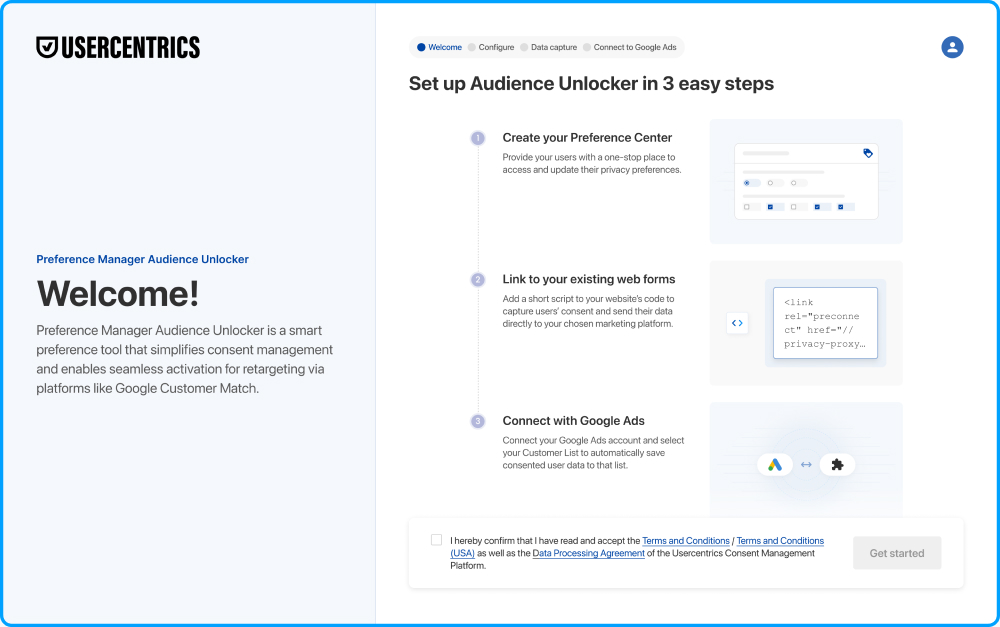
Audience Unlocker features
Take a look at some of the handy features that help protect your marketing activities and boost efficiency.
- Integration with your existing web forms: No need to build separate interfaces, you can easily plug Audience Unlocker into existing registration and contact forms.
- Automated data synchronization: Get real-time updates to ensure that consented data is accurately signaled to Google’s ad platform, preventing the risk of compliance gaps.
- Compliance dashboard and audit logs: Maintain visibility into all user consent actions over time so you meet regulatory and business requirements for transparency and traceability.
- User-friendly dashboard for your users: Your users can access a dedicated and easy to use dashboard within the Preference Center to view and update their privacy and preference choices.
How can you get Audience Unlocker?
Join our waitlist — click on Get Free Early Access and you’re in! Become an early adopter and try it for free.
Small and medium-sized companies and digital marketing agencies must meet and maintain all of the same data privacy requirements that enterprise companies do, just with fewer resources. So, saving time and streamlining work for your campaigns is extra valuable.
As user privacy expectations continue to evolve, Google has recently updated its data privacy and consent requirements in Europe, the UK, and Switzerland, and is facilitating easier adoption of Google consent mode to help meet these requirements. Consent management platforms (CMPs) that are certified by Google, like the Usercentrics CMPs, can now be implemented right from the Google Ads, Analytics, or Tag Manager interface.
Digital marketers in EU markets can now take steps to ensure they can continue targeting ads, measuring conversions, and generating revenue while meeting Google’s European Union user consent policy.
Collect and signal user consent to meet Google’s requirements and prepare for the era of privacy-led marketing. Respect user consent preferences while continuing to use Google services for your marketing operations. Continue the success of your measurement, ad personalization, and retargeting features for your campaigns.
Usercentrics CMP implementation in the Google tag UI
Google consent mode should be used with a CMP to signal user consent information to Google services. All of the Usercentrics CMPs are certified to meet the necessary requirements by Google: web and mobile, and CookiebotTM Web CMP.
Now you can create your Usercentrics account, set up your consent banner, and enable Google consent mode v2. All in one place in just a few clicks.
Read about consent mode GA4 now
What setup happens in the Google tag UI?
When you are logged into your Google Ads, Analytics, or Tag Manager account and click to set up the Usercentrics CMP, this is what happens:
- Usercentrics account setup
- Creation of your CMP banner configuration
- Google Ads and Google Analytics selected and added to the consent banner as data processing service per default
- script tag retrieval — Google pushes the Usercentrics CMP scripts to your website via Google Tag Manager or Google tag (gtag.js)
What setup happens in the Usercentrics Admin Interface?
Once you’ve completed most of the setup in your Google Ads, Analytics, or Tag Manager account, this is what you will finish up in your Usercentrics account using the Admin Interface:
- Customization of your consent banner design and content
- Addition of tracking services to your CMP (Google Ads and Google Analytics are added automatically)
Find all the instructions for the Usercentrics CMP setup in your Google Ads, Analytics, or Tag Manager account here.
“It’s now easier and more seamless than ever for SMEs to meet Google’s requirements and limit disruption to their digital marketing operations.” – Eike Paulat, Director of Product at Usercentrics
Benefits of Usercentrics CMP for Google customers
In addition to being Google-certified, Usercentrics Web and App CMPs have integrated the latest version of Google consent mode and the TCF v2.2. Usercentrics CMP also provides marketers with the following benefits for great user experience and streamlined consent management for a better privacy experience and optimizing campaigns:
- 2,200+ legal templates for reliable legal expertise that saves time and resources
- geolocation rules to display relevant banners to visitors in specific locations around the world
- banner auto-translation for 60 languages for clarity and personalized user experience
- extensive customization options to fully match your design and branding
- in-depth analytics and A/B testing for opt-in rate optimization
- cross-platform and cross-device functionality with web and app versions
We’ve told our customers that our focus is on delivering the best products to benefit their privacy-led marketing operations and data privacy compliance, and we’re delivering. With Usercentrics CMP V3 we have new features and performance improvements to share, and we think you’re going to be as excited about migrating as we are. We explain what’s changed, how it benefits you, how to upgrade, and more.
What is Usercentrics CMP V3 and what does it deliver?
Usercentrics CMP V3 is the latest version of our Consent Management Platform solution to enable you to obtain valid consent from your website visitors, ecommerce customers, app users, TV viewers, and more. It also enables you to achieve high consent rates to get the data you need for your marketing operations, and provides peace of mind with its reliability and automation.
With V3, we particularly focused on improving the performance of the CMP on the web, and bringing you features that would make the user experience even better.
All the other great features you’ve come to rely on, like Cross-Domain Consent Sharing, Preview & Publish, and Geotargeting, continue to help you create great user experiences and optimize your consent rates and streamline privacy compliance.
What are noteworthy features available in Usercentrics CMP V3?
Consent History
With Consent History, end users can send Usercentrics customers their ControllerID, which they can retrieve from the CMP’s second layer. The Usercentrics customer can then input the ControllerID into an input field in the Admin Interface and with the click of a button download a CSV file containing the consent history for that ControllerID.
This function is particularly useful to streamline data subject access requests.
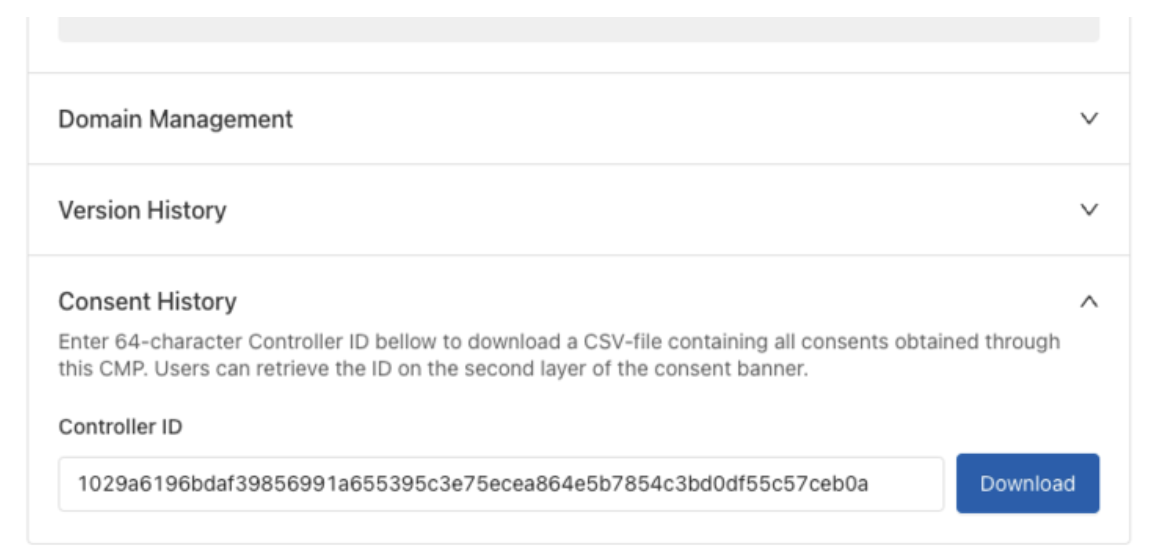
Admin Interface showing new Consent History function
How Usercentrics CMP V3 has improved web performance?
V3 brings great improvements in all business-critical areas. The smaller fingerprint of the V3 CMP results in better Lighthouse scores and Core Web Vitals.The newest script of Usercentrics has increased the performance of our CMP significantly, reaching a Core Web Vitals score of up to 100, on average ranging between 93-100 when other website elements impact metrics such as Largest Contentful Paint (LCP) and Cumulative Layout Score (CLS).
An important example of performance improvement is that critical parts of the business logic that resided in the Browser SDK in V2 have been moved to a backend API, which produces tailored responses for all Usercentrics customers. The API returns many of the actual properties that were previously calculated in the SDK in one cacheable JSON response.
V3 reduces the kB transferred to the client side by ~70 percent, and the number of network requests performed by ~60 percent.

Core Web Vitals report for usercentrics.com/de/
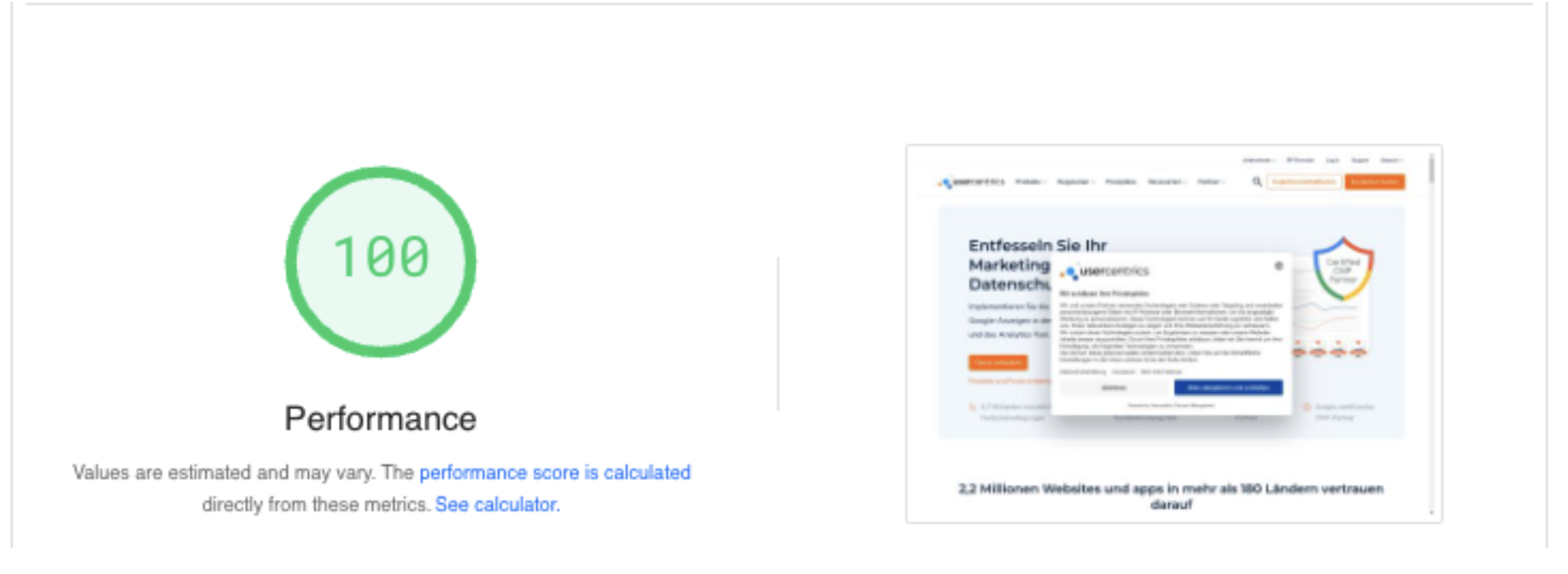
How Usercentrics CMP V3 has improved user experience?
The new Consent History and manual resurfacing features are available in the Admin Interface with just the click of a button to help you meet regulatory requirements.
We’ve also significantly upgraded CSS customizability from V2 to make it even easier for you to maintain consistent brand look and feel, and to optimize your consent banners based on insights from Interaction Analytics.
In the Implementation of the Admin Interface you can also now explore the V3 Script Tag to experience the boost in CMP performance.
The V3 performance improvements also mean a faster, smoother experience for end users, which provides better user experience and encourages more engagement.
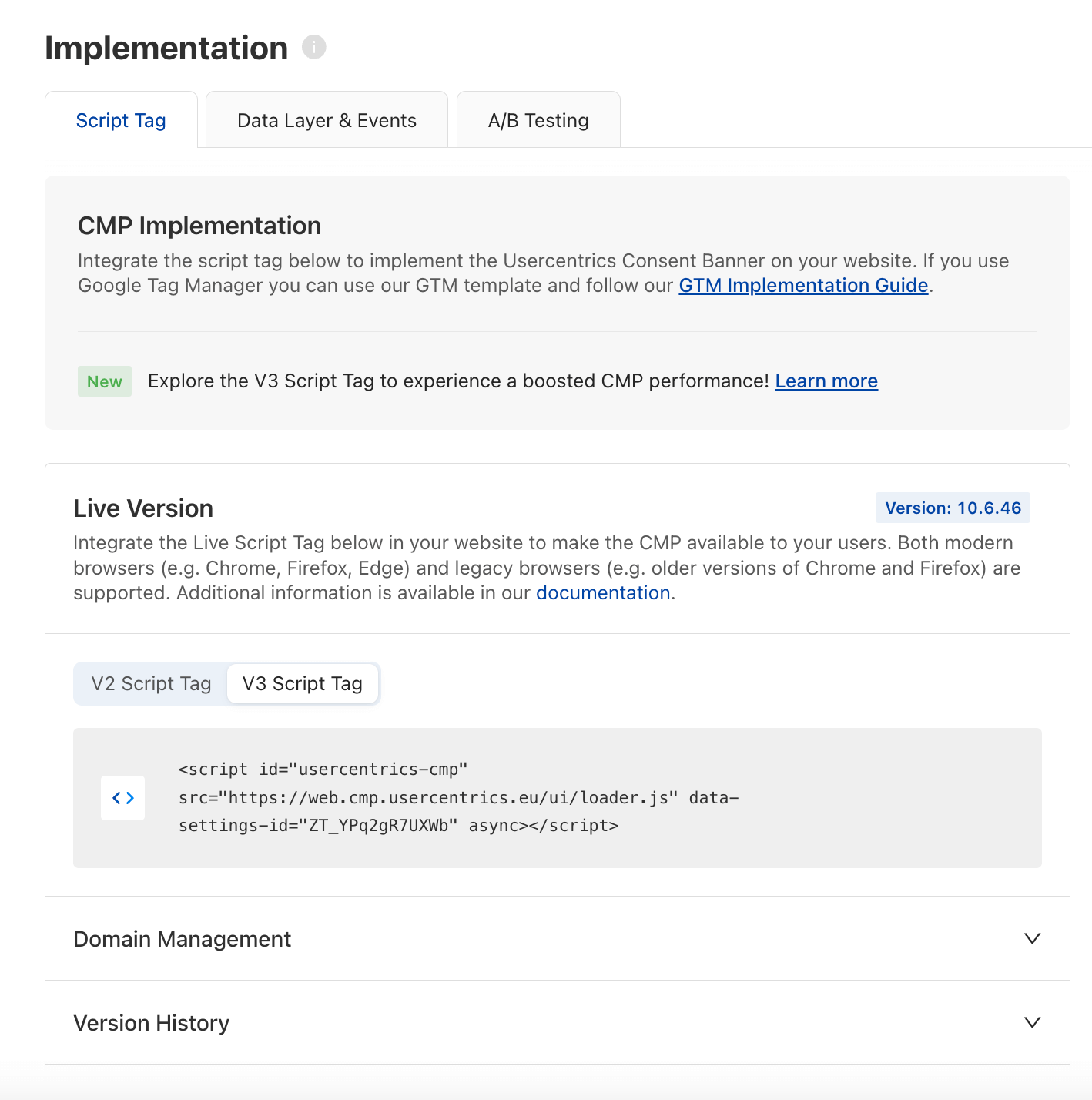
How to migrate to Usercentrics CMP V3?
There’s an easy checklist to help you migrate to Usercentrics CMP V3:
- Exchange the CMP script tag
- Adjust the styling of your CMP (if using custom HTML)
- Adjust the content if needed (e.g. banner message)
- Optionally, also adjust:
- API
- HTML Embeddings
- Event Listener
- Privacy Link
We have documentation to help you migrate to Usercentrics CMP V3.
- Browser UI integration – walks you through the required script update.
- The step-by-step guide enables you to configure Usercentrics CMP V3 to support TCF 2.2.
Get started with Usercentrics CMP V3
You’re busy and your focus is on your core business, so why not make achieving and maintaining privacy compliance even easier with Usercentrics CMP V3? The new features and performance improvements also make it easier to deliver great user experience to your end users to optimize consent rates and get the data you need.
To get started using Usercentrcis V3 script, just log in to the admin interface to get the new script or get in touch with your Customer Success Executive today.
Cookies play a crucial role in enhancing online experiences, making websites more functional and personalized, and enabling digital marketing. The shopping cart that stores your customers’ items while they continue to browse? That’s made possible via cookies, for just one example.
Cookies have also evolved into sophisticated tools for tracking user behavior, and empower businesses with valuable insights to boost engagement and optimize marketing activity, amongst other things. However, with this increased functionality comes consumer privacy concerns and regulatory requirements.
Companies that do business in the EU and collect personal data from EU residents in the process must comply with the General Data Protection Regulation (GDPR), which requires clear, unambiguous, and freely given user consent before collecting or processing personal data. It also requires transparency about cookie usage, and a defensible legal basis for data collection, among other stipulations.
Businesses must also keep up with evolving standards from industry leaders like Google (Alphabet), which, along with other designated “gatekeepers,” has to comply with the Digital Markets Act (DMA) — and as a result has levied data privacy requirements on its customers.
The DMA mandates that the gatekeepers meet certain requirements designed to encourage fair competition in digital markets and uphold the privacy rights of users. This adds another piece to the privacy compliance puzzle.
To navigate this landscape and continue to grow digital marketing operations, you’ll need to blend robust privacy practices with consent management software. By finding innovative ways to leverage cookie technology while complying with data privacy regulations, you can enhance the user experience, build trust, and protect advertising revenue.
Cookies, the GDPR, and “cookie law”
While cookies play a pivotal role in enhancing user experience and delivering personalized content online, they can also raise significant privacy concerns, particularly the use of third-party cookies, which track users across websites.
The personal data collected can, in some cases, be used to identify individuals, and some of it can be quite sensitive, including financial details.
These concerns are addressed by the GDPR and the ePrivacy Directive (ePD), which mandate measures to ensure that an individual’s personal data is handled securely, with consent, and that the end user is provided with clear information about data handling, their rights, and consent options.
Let’s break down how these regulations impact cookie use and what businesses need to know to stay compliant.
How cookies are affected by the GDPR and the ePrivacy Directive
The GDPR and the ePrivacy Directive govern the usage of cookies. The GDPR outlines the conditions for explicit user consent and a valid legal basis for processing personal data, while the ePrivacy Directive focuses on the privacy implications of electronic communications.
What the GDPR says about cookie use
- Under the GDPR, information collected via cookies that can identify an individual — directly or indirectly — is considered personal data.
- Websites that use cookies must obtain consent from users before any data collection or processing takes place.
- Consent must be “freely given, specific, informed and unambiguous,” involving direct action by the user, like ticking a box. Pre-ticked boxes do not qualify, nor does only allowing the option you want, like presenting only an “Accept” button. The user must be notified how their data will be processed, stored, and shared, including information on any third parties that will have access to their data.
What the ePrivacy Directive says about cookie use
- Also known as the “cookie law,” the ePD complements the GDPR by requiring prior consent for cookies and similar tracking technologies, with the exception of those strictly necessary to provide a service explicitly requested by the user.
- The ePrivacy Directive mandates that users are provided with clear and comprehensive information about why any personal data is collected, stored, or accessed.
Key requirements of the GDPR and the ePrivacy Directive include:
- Consent: When used as the legal basis, websites need to provide a user-friendly way for users to give, change, or withdraw consent. All options must be equally presented, and users should be able to give or reject consent at a granular level, e.g. for specific categories of cookie use.
- Right to withdraw: Users must be able to withdraw their consent as easily as they gave it.
- Transparency: Information about cookie use must be clearly articulated in a privacy policy or cookie notice. This includes which cookies are active, what their purpose is, and how long they will remain in place.
These regulations apply to the various kinds of cookies and to similar technologies that store or access information on a user’s device, such as:
- Session cookies and persistent cookies: Whether they expire when users close their browser or remain longer, these cookies must comply if they collect personal data.
- First-party and third-party cookies: Both types of cookies need to adhere to these privacy laws, whether set by the website owner or a third party (like advertisers).
- Other technologies: This includes web beacons, pixel tags, and local storage used to track users and store information.
Businesses must conduct regular audits to identify and manage all such technologies used on their sites as they change over time, to ensure ongoing compliance with both the GDPR and the ePrivacy Directive.
A high performance consent management platform will include a cookie scanner that can scan sites regularly to detect and manage the cookies and trackers in use on websites, including hidden third-party ones that may change regularly.
GDPR cookies compliance myths
Cookie compliance misinformation can result in either overly cautious practices that hinder user experience or access to needed data, or insufficient preparation that risks noncompliance and potential penalties.
Debunking these myths will help to ensure your approach to cookie management is both effective and primed for GDPR compliance.
“My website doesn’t collect personal data.”
Many website owners assume that their site doesn’t collect personal data, especially if they’re only tracking website performance or functionality. Under the GDPR, however, the definition of personal data is broader than many realize.
Even cookies used for advertising or analytics often collect information that can, directly or indirectly, identify an individual. This includes IP addresses or unique identifiers within cookies.
In reality, nearly all cookies capture some form of personal data, bringing such practices under scrutiny from overseeing authorities.
“Cookies are not personal data, which is why the GDPR does not apply.”
While cookies themselves are not personal data, the data they collect can be. According to Recital 30. GDPR, identification is possible via online identifiers such as IP addresses or cookie identifiers. As such, it will depend on the kind of cookie in place as well as the data being collected.
It’s also wrong to assume that cookies are only regulated under the ePrivacy Regulation, which is expected to be in full effect by 2026.
While intended to replace the ePrivacy Directive of 2002 and the Cookie Directive of 2009, the forthcoming ePrivacy Regulation covers the processing of all electronic communications data, regardless of identifiable personal data. Read more about the ePrivacy Regulation below.
“I don’t need a cookie banner.”
Cookies collect personal data irrespective of the intended use, so you are required to inform users about the collection and processing of their personal data. Provided information must include: what data is collected, how it’s processed, for what purpose, and on what legal basis.
Furthermore, the website operator must communicate how long the data is kept, who will have access to it, how they can contact the controller (the entity collecting personal data, like a website owner), and where they can revoke their consent.
“Telling users the site uses cookies is enough for compliance.”
Simply informing users that your site uses cookies is not sufficient for GDPR compliance, just like only presenting an “Accept” button for consent is not sufficient. The regulation demands a higher standard of transparency and user control.
Websites must provide clear, specific information about the types of cookies being used, the data they intend to collect, the purpose for processing, and who has access to this data.
Additionally, consent must be explicit and informed. This means users should be given the choice to accept or reject non-essential cookies without impacting their access to the website and its features.
Providing comprehensive cookie notices is crucial to ensure that users are fully aware of their choices and have meaningful control over their personal data.
A cookie notice can be a separate page on the website, but it’s commonly a section in the broader privacy policy. Regardless, like the privacy policy, it must be easy to access and understand for the average visitor.
“If I have a cookie banner in place, I’m safe.”
Having a cookie banner doesn’t mean you are automatically GDPR-compliant. The GDPR defines seven criteria for collection to be valid within the meaning of the Basic Data Protection Ordinance.
This means that the website operator must obtain the user’s consent via its cookie banner per these criteria.
Moreover, compliance with other global privacy laws does not guarantee GDPR compliance. The GDPR has stringent and specific consent requirements that differ significantly from other jurisdictions.
For example, the GDPR uses an opt-in model for consent while US regulations such as the CCPA use an opt-out model.
“The ePrivacy Regulation will not affect the use of cookies.”
The ePrivacy Regulation contains additional provisions for the use of cookies. While essential cookies used for the technical operation of a website do not require the user’s consent, those used for tracking or advertising purposes require explicit, active, and voluntary user consent.
It is also not compliant to try and categorize marketing cookies as essential, for example, in order to skirt consent requirements.
The ePrivacy Regulation is intended to counteract and eliminate cookie walls. Accordingly, all of the website must be accessible, even if the user has not consented to the use of cookies.
GDPR cookie policy checklist
As you can see, these myths and assumptions can lead to confusion and compliance risks for website operators.
The following points should be noted to use cookies in a GDPR-compliant manner.
Duty to provide information
Cookie banners (aka consent banners) should include all necessary information, including how cookies are used on each web page.
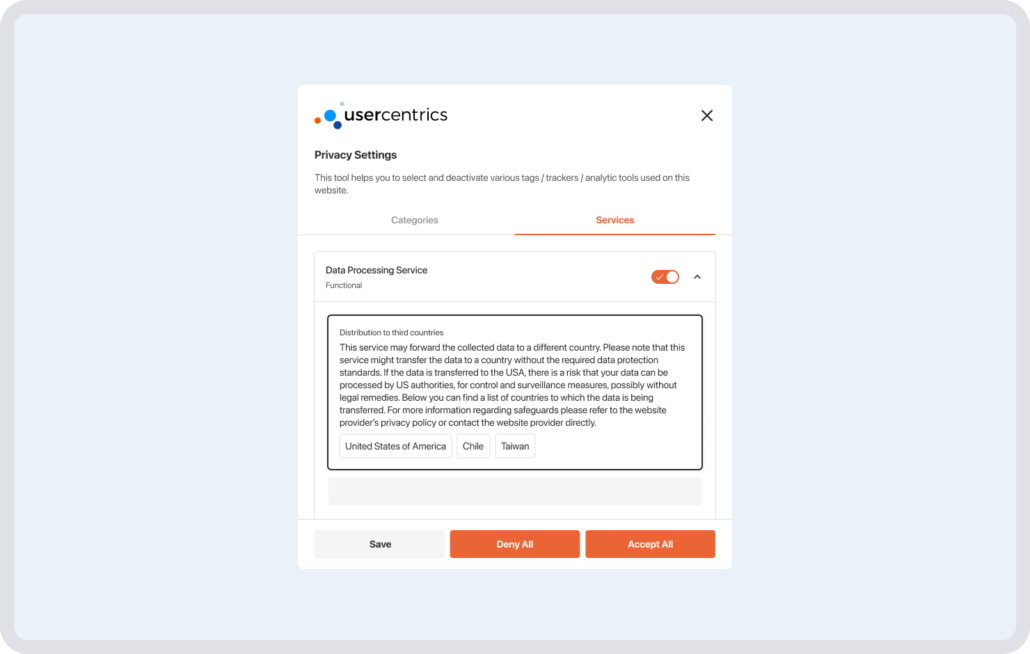
Consent banner with granular user Privacy Settings options and Data Processing Services information
Furthermore, as per Art. 21 GDPR, visitors should know if their data is used to create profiles and if their data may be transferred to third parties in countries outside of the EU. This is needed if the cookie technology providers are based in the US, for example.
Active consent
The cookie banner must ensure that the user can give their informed consent in advance, voluntarily, explicitly, and granularly for each web technology or category of technologies (or bundled for individual use areas).
There must also be a straightforward and simple way for users to object to the processing of their personal data, or to withdraw their consent.
Loading cookies
Under the GDPR, you may not use cookies to process or collect any data without a legal basis. Plus, cookies may not load until consent has been granted, meaning there must be a technical link between the cookie banner and your web technology. If the user refuses processing, cookies cannot be loaded.
Usercentrics CMP enables you to control cookies and block them until consent has been obtained. With the Google Consent Mode integration, it also signals consent information to Google services, controlling their function and data collection based on consent status.
Legally compliant documentation
In the event of a review by data protection authorities, the website operator must comply with its documentation obligation and be able to demonstrate their users’ consent.
To ensure all data is available in the event of an audit, various data points should be documented, including timestamps, user agents, and the version of the consent text.
The condition under which consent was given is also important — how large the “Accept” button was compared to the “Reject” button, whether the choice was voluntary, could the user use the site unhindered even when rejecting cookies, etc.
Most data privacy laws also include the right for consumers to know if website operators are collecting data about them, and to access a copy of that data, of which consent data is a part. This is another reason robust and secure documentation is important.
Opt-out
According to the GDPR, the process to opt out must be as straightforward as opting in. This ensures that users can easily decline the use of cookies initially, and similarly, can just as easily change their preferences or withdraw consent at any time.
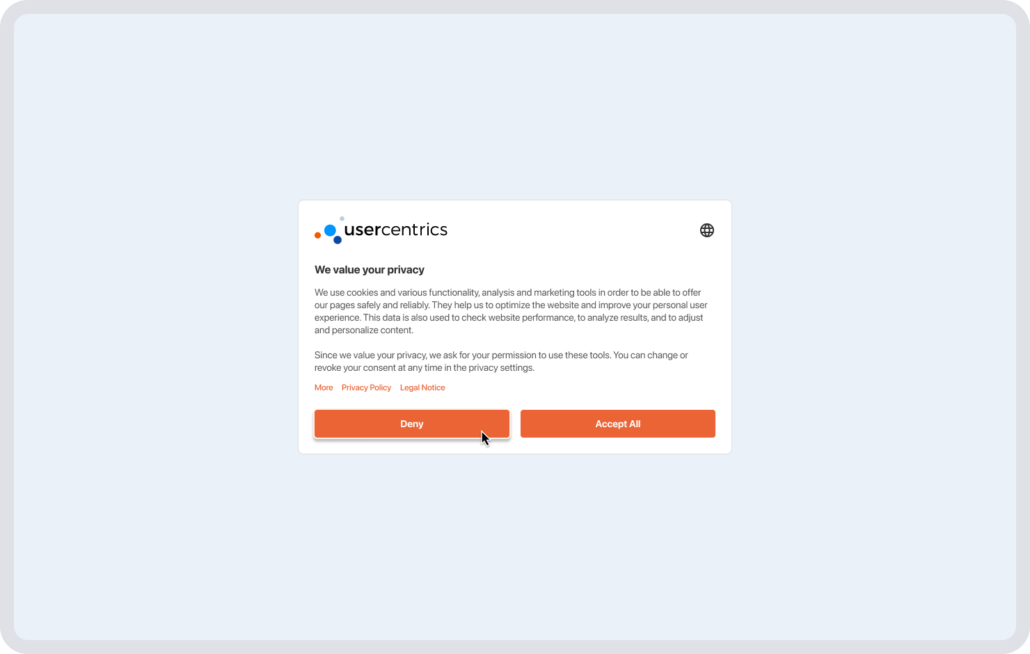
Consent banner with data processing information, consent buttons, and informational links
It’s not sufficient to direct users to external links or third-party pages to opt out. From the moment a user opts out, no further data should be collected or forwarded to any third parties. Any processing taking place on the controller’s behalf by third parties must also cease right away.
Therefore, the opt-out mechanism must be technically integrated with the cookie settings on your site and documented for compliance and transparency. This approach helps meet legal requirements and builds trust by respecting user choices at every step.
How to ensure GDPR cookie compliance
Ensuring GDPR cookie compliance involves following a series of regulatory requirements and data protection best practices that also help build user trust and form the foundation of privacy-led marketing.
- Have a cookie policy: Clearly outline what cookies are used, their purpose, and how data is managed in a cookie policy. This policy should be easily accessible on your website, either as an independent document or as part of the privacy policy.
- Implement cookie consent banners: Present contextually relevant consent banners. For example, when a user first visits your site, provide them with immediate, clear options to accept or reject non-essential cookies. Ideally use geotargeting to determine which regulations are relevant to the user, with multi-language support to present consent information in the visitor’s preferred language.
- Obtain granular consent: Enable users to give separate consent for different types of cookies (e.g., analytics, advertising). This helps ensure that consent is specific and informed.
- Monitor tracking technologies: Continuously review and update the cookies and tracking technologies present on your site to ensure they comply with the latest legal standards and technical requirements. A robust scanner built into your CMP can automate this to save time and resources.
- Optimize consent mechanisms: Ensure that consent mechanisms are intuitive and enable users to withdraw consent as easily as they gave it. This can be streamlined using a consent management platform like Usercentrics.
Google has specific requirements of its own, especially concerning how advertisers use cookies and data.
With Google Consent Mode, you can adjust how your Google tags behave based on the consent status of your users. This ensures that you continue gathering valuable data while still complying with the GDPR by respecting user preferences about cookies and data tracking.
Usercentrics is a Google-certified CMP that integrates with the latest version of Google Consent Mode. Plus, with its library of over 2,200+ legal templates and comprehensive Data Processing Services (DPS) Scanner Usercentrics enables you to obtain, document, and signal granular cookie consent.
Managing cookies under the GDPR with Usercentrics
There’s a lot to consider when it comes to cookie compliance under the GDPR, but consent management tools like Usercentrics CMP simplify the process of collecting, managing, and signaling valid consent significantly.
Usercentrics provides a comprehensive solution for collecting, processing, and securely storing granular cookie consent, managing cookie banners, and documenting user consent as required by the GDPR. Speak to a Usercentrics expert today.
In a landscape where businesses can no longer take customer loyalty for granted, personalization plays a vital role. But enabling customers to feel in control of interactions with businesses is critical to get personalization right.
According to a 2021 report by McKinsey & Company, 71 percent of consumers expect companies to deliver personalized interactions. And when their expectations aren’t met, 76 percent of these consumers experience frustration.
To deliver customized messaging, interactions, and measurement that take customer preferences into account, businesses first need to request, collect, and store customer consents and preference information — while providing their consumers with the transparency and control over their personal data that they now expect.
These expectations have brought changes in regulation, like the Digital Markets Act, as well as shifts in consent and data management, and marketing strategies, such as Google’s plans to phase out third-party cookies in Chrome by 2025.
Evolving expectations have also impacted the move away from second- and third-party data — and the types of cookies and other tracking technologies used to obtain it — and instead center data and marketing strategies around customers’ expressed preferences by way of first- and zero-party data.
In short, businesses now need to balance consumer expectations for personalized experiences with data privacy compliance requirements from governments and the influential tech platforms that they rely on. As a result, preference management tools that combine and centralize user preferences are now indispensable, especially when they integrate with the full marketing stack.
In this article, we share insights about preference management tools and our top software picks for 2025. From seamless platform integrations to sophisticated segmentation and targeting capabilities, these tools help privacy-aware businesses build trust with their customers and drive revenue growth.
The top preference management tools for 2025:
| Preference management tool | Key features | Recommended for | G2 rating |
|---|---|---|---|
| Usercentrics | Centralized, multi-access preference dashboard
Exportable data Seamless integrations |
Medium-to-large businesses | 4.5 |
| TrustArc | Customizable consent prompts and data intake forms
Rapid API Deeper personalization capabilities |
Large organizations, government, and public sector | 4.2 |
| OneTrust | Centralized preference management
Customizable user interface |
Large enterprises and multinationals, digital and ecommerce platforms | 4.3 |
| Osano | Real-time preference updates
Seamless integration with major platforms Advanced segmentation capabilities |
Small to medium-sized businesses | 4.6 |
| Didomi | User-friendly interfaces
Cross-platform consistency Global compliance framework |
Technology and software companies, healthcare and pharmaceutical organizations | 4.6 |
| PossibleNOW | Centralized preference management
Omnichannel capability Do Not Contact compliant |
Medium to large organizations | 4.7 |
| Clarip | Omnichannel capability
Focus on mobile and social media marketing Customizable user interfaces |
Ecommerce platforms, financial services, healthcare organizations | 4.8 |
| Cassie | Recognized by Gartner
Customer Service Portal API integration |
Healthcare, financial, and educational institutions | N/A |
Preference management platform benefits
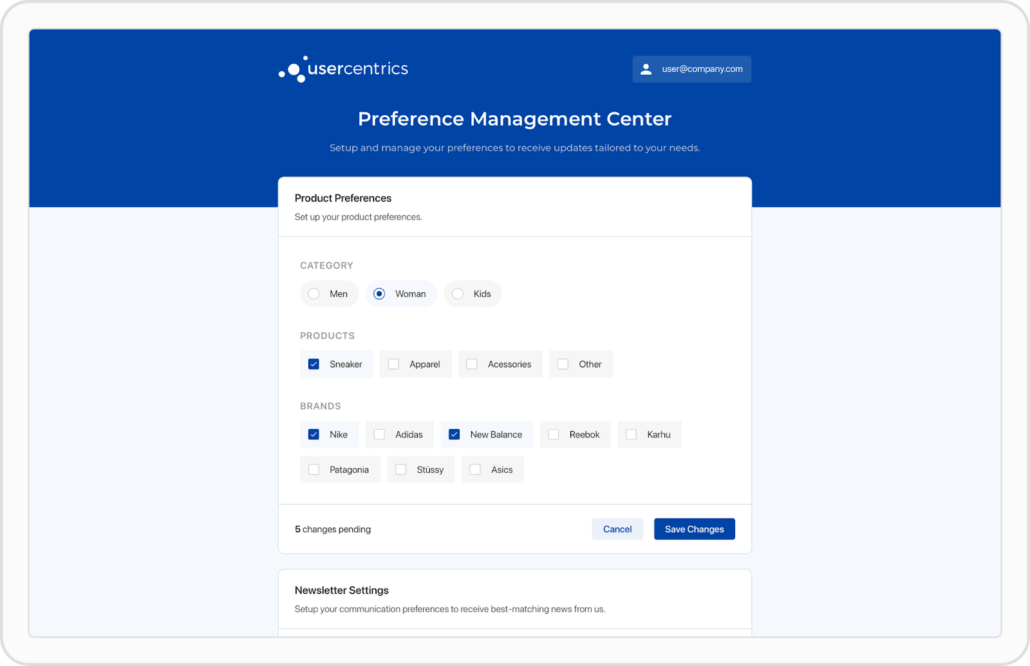 The Usercentrics Preference Manager is fully customizable to your brand identity, and enables you to collect granular user preferences.
The Usercentrics Preference Manager is fully customizable to your brand identity, and enables you to collect granular user preferences.
Preference management platforms stand at the crossroads of customer experience (and satisfaction) and data privacy compliance. They can define and transform how businesses interact with their audiences.
From contributing to privacy compliance operations to delivering personalized customer experiences, here are the top benefits of this powerful class of software.
Improves centralization and data accessibility
Preference management makes it easier to centralize and access your customer’s first- and zero-party data, enabling granular personalization according to user preferences.
Say goodbye to department-specific silos. Your whole organization can access and share data, with built-in security and administrative controls, so users’ stated preferences can be centralized and accessible to various business functions to help ensure privacy compliance and respect for preferred customer interactions across the organization.
This is also valuable for regulatory requirements, centralizing the consent and preference data (and updates to it over time) that’s used across the organization, for a single-source audit trail if data protection authorities inquire.
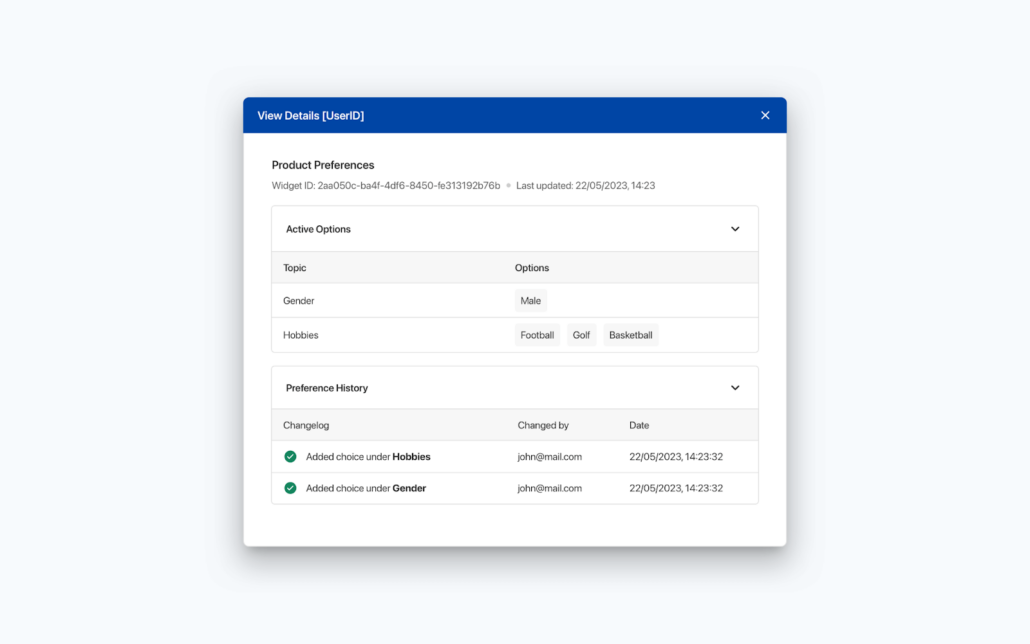 The Usercentrics Preference Manager keeps detailed records of consumer preferences.
The Usercentrics Preference Manager keeps detailed records of consumer preferences.
Provides personalized services
Preference management software helps you get to know your customers more personally, as it takes direct cues about what interests them based on what you ask them about, and the resulting first- and zero-party data they’ve shared with you.
When you’re equipped to provide personalized service, you can cater to the preferences of all customers, not just the larger segments. Do certain segments want to opt out of email? No problem. Do other users just want email updates about special offers and promotions? You can make it happen, increasing engagement and demonstrating your respect for customer consent and preferences.
Read about email marketing privacy policy now
Access scalable storage
The best customer preference management solutions provide secure, scalable storage for the first- and zero-party data you collect, and integrate with other marketing tools and platforms.
They also enable you to perform data housekeeping more systematically. For instance, you can nudge customers to check and update their data, saving you a massive amount of manual work and ensuring greater accuracy. This is also important for data privacy compliance, helping ensure user data is accurate, and only retained as long as necessary.
Notifying customers when their data has been accessed or updated, even if it’s by the customer themself, is also a trust-building signal of your security measures.
Improves customer relations
Consumers are more digitally savvy than ever before. They understand that their relationships with brands are transactional. But they also know how much data companies have about them. They expect it to be used judiciously, and to cater to their preferences in channels, messaging, products, deals, and more.
Consumers who feel understood and respected — and recognize that companies are crafting personalized experiences for them based on what they want — are more engaged and loyal, especially over time.
Enables relevant communications and higher engagement
Customers and brands also have more communication channels than ever before. It’s an opportunity for more consistent engagement and more precise customization for various demographics. It makes determining which channels have the highest ROI easier than ever.
Whether a customer prefers text messages, emails, in-app notifications, or postcards, you can communicate accordingly and automate your efforts at scale.
8 best preference management solutions
1. Usercentrics Preference Manager
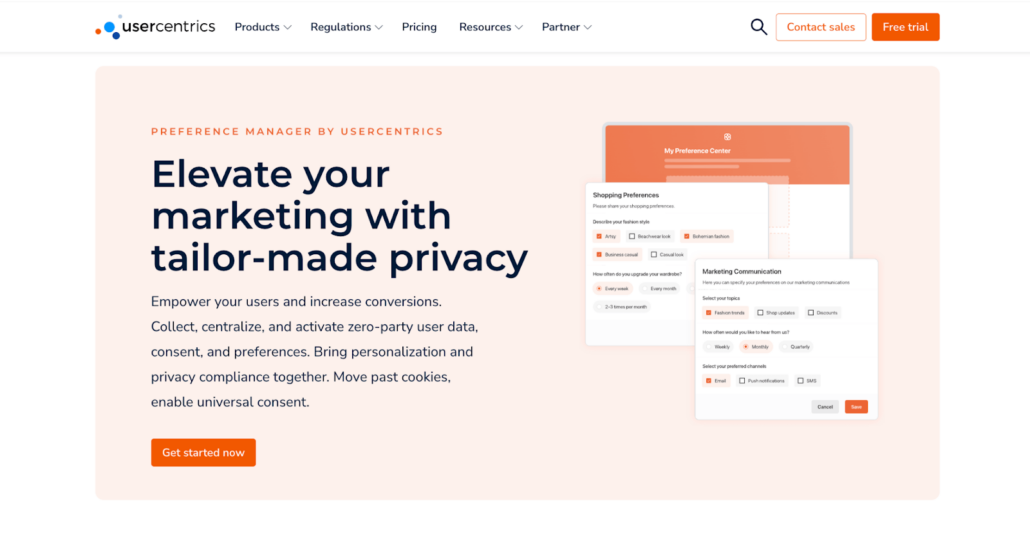
Usercentrics provides consent management and preference management tools that empower businesses to achieve compliance with global data protection regulations like the General Data Protection Regulation (GDPR), California Consumer Privacy Act (CCPA), and more.
Usercentrics platforms provide businesses with the tools to collect, manage, and document user preferences and consent transparently and in a user-friendly way, via the Usercentrics Consent Management Platforms (CMPs) and Preference Manager.
The Preference Manager tool is a central point for collecting, consolidating, and activating zero-party user data, consents, and preferences. This enables you personalize your communication and deliver a brand experience aligned with your users’ stated preferences, while respecting their privacy choices at every touchpoint.
Usercentrics Preference Manager features
- Complete centralization: One-stop, intuitive portal that enables full user control over expressed permission and preference data. You also gain a granular overview of users’ preferences and permissions, which can drive marketing strategy and be signaled throughout your marketing tech stack.
- Fully secure: Ultra-secure thanks to hashing and double opt-in. Includes an automated, time-stamped, and in-depth audit trail.
- Capture and manage granular preferences: Provide full control over marketing preferences and permissions and build stronger, privacy-focused strategies. Includes customizable widgets that enable you to capture granular permissions and preferences to deliver top notch customer experiences.
- Multi-channel collection: Collect first- and zero-party data across your websites and apps. Easily integrates with your marketing tech stack.
- Hassle-free setup: Easy to set up and intuitive to use. Fully customizable to your brand identity and available in multiple languages. Export data for easy integration into existing systems and processes.
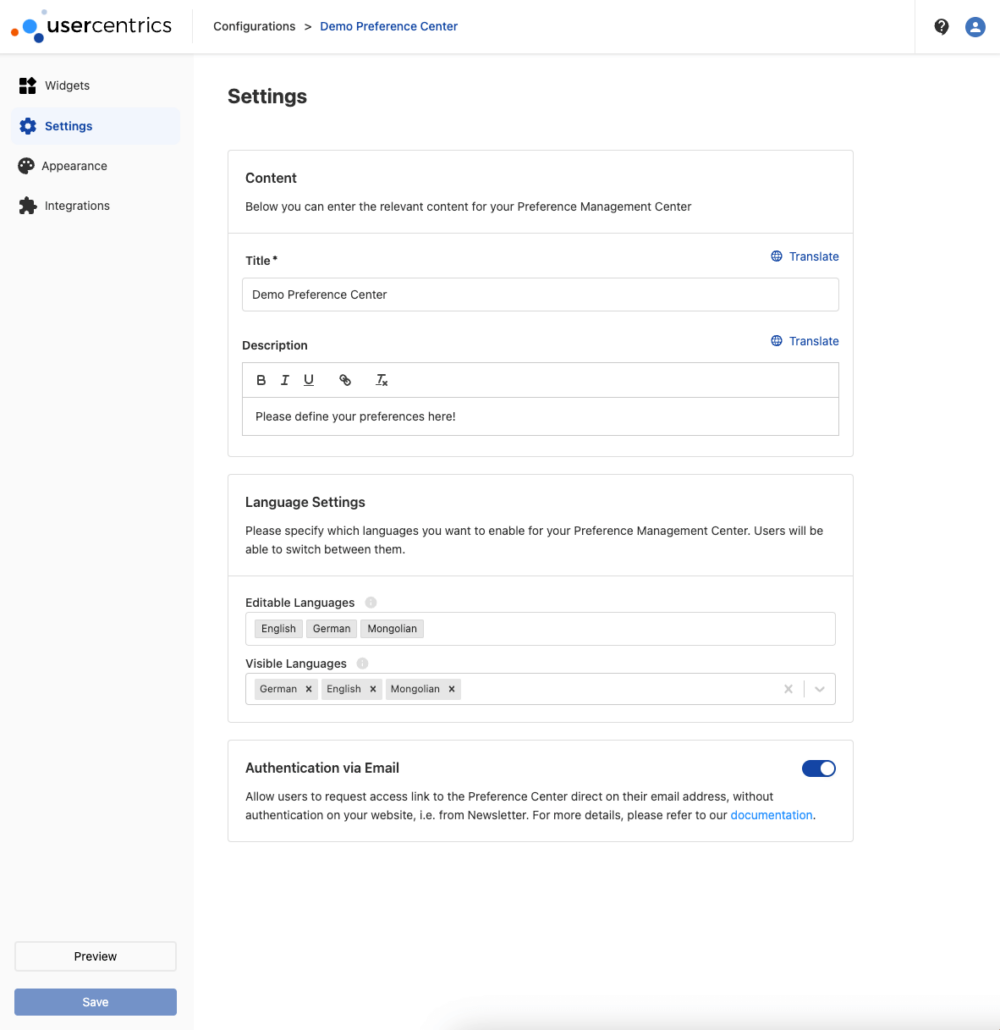
Usercentrics Preference Manager pricing plans
Usercentrics calculates pricing for its preference management tool by the volume of handled data. This is based on the number of users who engage with the tool, not the platform (website/app) sessions. For specific pricing, chat with a Usercentrics expert.
| Pros | Cons |
|---|---|
| Ease of use | Learning curve for advanced features reported by some G2 users |
| Extensive customization | |
| Cross-channel preference collection |
2. OneTrust Universal Consent and Preference Management
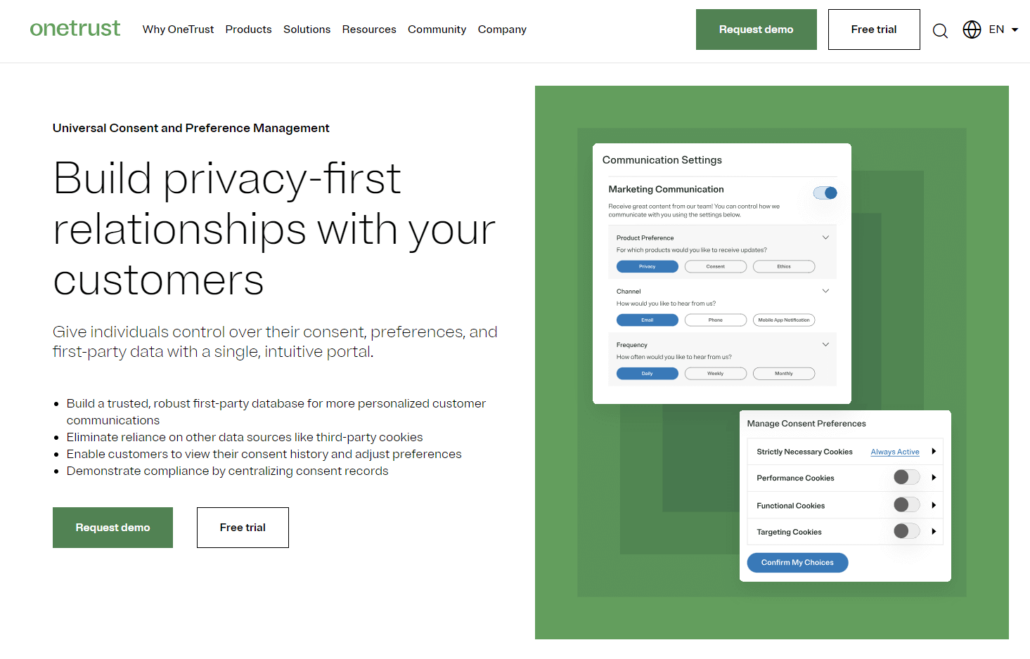 OneTrust Universal Consent and Preference Management
OneTrust Universal Consent and Preference Management
OneTrust provides a privacy management and compliance software tool that helps organizations navigate data privacy regulations, such as the GDPR and CCPA. The company an end-to-end solution for privacy, security, and third-party risk management, a one-stop shop for data governance.
OneTrust offers universal consent and preference management functionality as part of its privacy toolkit. This enables users to control all their consents, preferences, and first-party data from a centralized location. The platform also helps customers roll out personalized communications and customer journeys.
OneTrust preference management features
- Centralized preference management: OneTrust enables centralized control over user preferences across multiple channels and touchpoints.
- Customizable user interface: To give consumers transparency into data collection, customize the user interface for consent and preference collection.
- Build enhanced customer profiles: Embed transparent data collection into the user journey and build richer customer profiles that enhance customer loyalty.
OneTrust preference management pricing plans
OneTrust offers personalized pricing information upon request.
| Pros | Cons |
|---|---|
| Excellent customer support, as per G2 reviews | Steep learning curve, according to G2 users |
| All-inclusive tool that covers consent and preference management | |
| G2 reviews praise the user-friendly interface |
3. Osano Unified Consent & Preference Hub
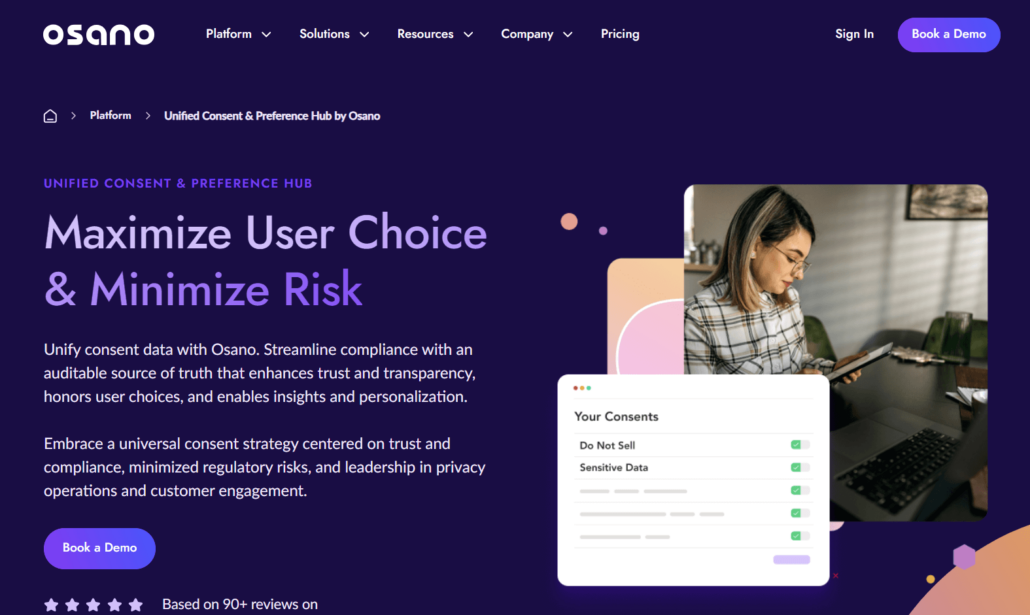
Osano is a data privacy platform that advertises its speciality in consent management and data privacy compliance. In addition to simplifying the process of obtaining, documenting, and managing user consent, the platform touts powerful data discovery and classification features.
Osano’s consent and preference hub also brings together user consents and preference management to enable a privacy-focused approach to personalization that meets consumer expectations and data compliance needs.
Osano Unified Consent & Preference Hub features
- Real-time preference updates: Users can update their preferences at any time, with changes instantly reflected across all platforms.
- Seamless integration with major platforms: Osano boasts easy integration with a wide range of content management systems, email marketing tools, and CRM platforms.
- Advanced segmentation capabilities: Osano enables user segmentation based on their consent and preferences, for more targeted and effective marketing campaigns.
Osano Unified Consent & Preference Hub pricing plans
The Unified Consent & Preference Hub is only available on the following plans:
- Privacy essentials
- Privacy operations & governance
Specific pricing information is only available upon request.
| Pros | Cons |
|---|---|
| G2 users review the tool as easy to use | Some G2 users have noted they would like more customization capabilities |
| Helpful support team, as per G2 reviews | |
| Ranked top by G2 users for easiest setup and fastest implementation in spring 2024 |
4. Clarip Universal Consent & Preferences
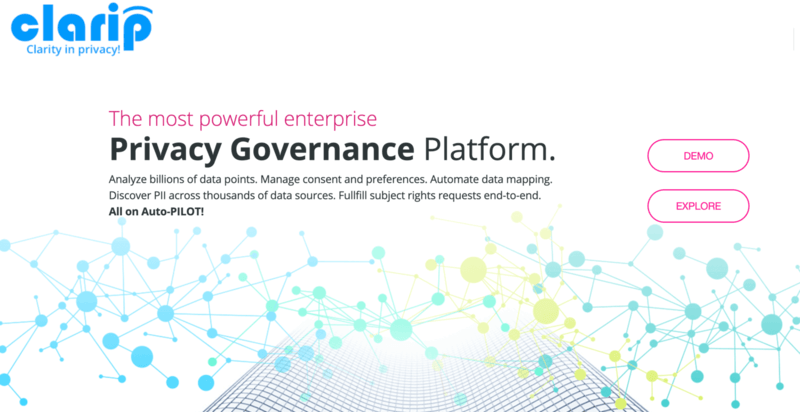
Clarip advertises enabling businesses to collect, manage, and act upon user preferences and consent across multiple channels in real time.
By unifying consent and preference management, plus providing users with direct control over their personal information and how it’s used, Clarip touts that they facilitate compliance with global privacy regulations, while building customer trust.
The company claims that its intuitive interface and robust integration capabilities can help customers tailor marketing efforts to meet audiences’ exact needs and preferences, leading to a more personalized customer experience.
Clarip consent and preference manager features
- Privacy-first customer portals: Clarip offers dedicated portals where customers’ users can directly and granularly manage their preferences and consent settings.
- Customizable user interfaces: The platform’s user interfaces are highly customizable, so companies can tailor the look and feel of their preference management system.
- Smooth integration: Companies can communicate consumer preferences to the rest of their marketing and CRM systems with Clarip API.
Clarip consent and preference manager pricing plans
Specific pricing information is only available upon request.
| Pros | Cons |
|---|---|
| While user reviews are few, some G2 users enjoy the wide range of privacy features | The tool has limited user reviews |
5. Didomi Preference Management
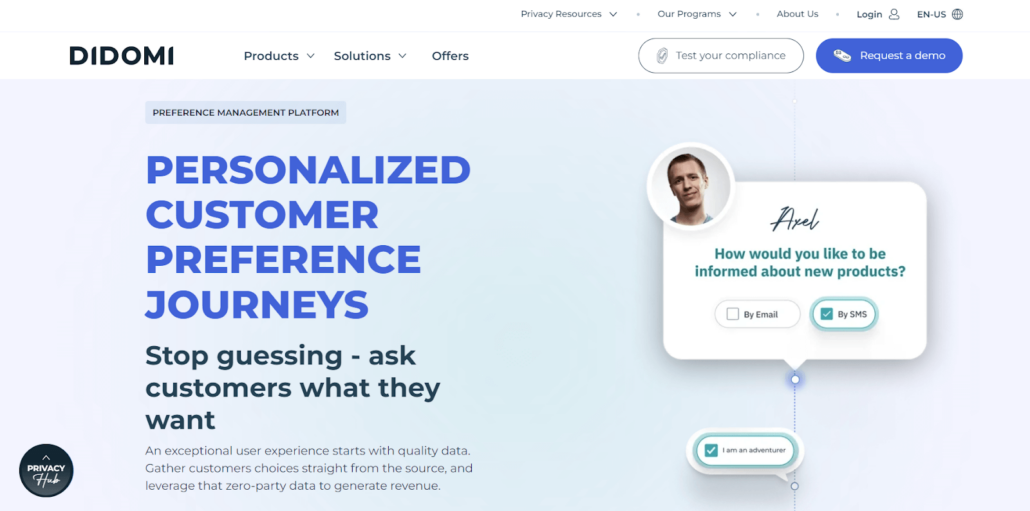
Didomi is a multi-platform provider of privacy solutions. It includes preference management functionality that enables companies to craft tailored experiences that match the needs of their audiences, as well as a consent management platform (CMP) they can use to gather, store, and leverage user consent.
Didomi advertises that together, these features equip companies to build trust, enhance engagement, and better align marketing initiatives with customer expectations while remaining compliant with privacy regulations.
Beyond its technical offerings, Didomi claims to set itself apart via proactive customer support and a wealth of educational resources that will help customers navigate the complexities of consent and preference management.
Didomi Preference Management features
- User-friendly interfaces: Intuitive and customizable preference centers that are designed to be engaging and easy to navigate for end users.
- Cross-platform consistency: Synchronize user preferences across all touchpoints, from mobile apps to web platforms and even in offline environments.
- Global compliance framework: Dynamic framework enables easily adjusting consent and preference management practices to comply with evolving regulations.
Didomi Preference Management pricing plans
Didomi offers three plans. However, Preference Management is only available on its Privacy UX Plus plan. Specific pricing is available on request.
| Pros | Cons |
|---|---|
| Excellent customer service reported by G2 users | A G2 user report of Didomi impacting their site’s performance poorly |
| Easy to use, according to G2 users | |
| Personalized consumer preference pages |
6. TrustArc Consent and Preference Manager
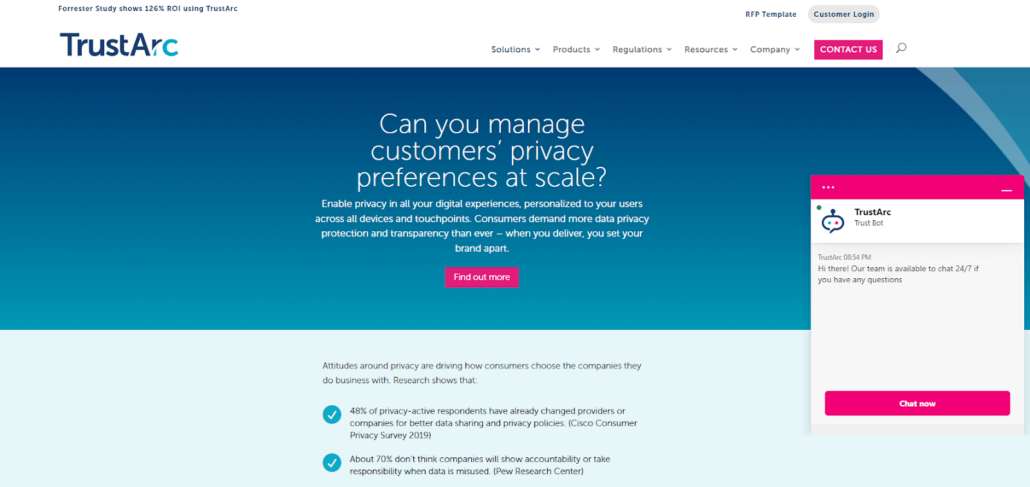
TrustArc‘s stated mission is centered around helping businesses of all sizes manage privacy risk, comply with complex regulations, and build trust with their customers through responsible data practices and granular preference management.
To that end, the platform provides solutions for privacy compliance, data protection risk management, and consent and preference management, enabling privacy throughout the customer journey.
TrustArc Consent and Preference Manager features
- Customization: Personalize consent prompts and data intake forms to provide the best possible customer experience.
- Rapid API: Sync consumer preferences and consent across marketing and vendor systems, in real time.
- Deeper personalization: Track consents against consumer profiles, making improving preference management and providing top-tier personalization easier.
TrustArc Consent and Preference Manager pricing plans
Pricing only available on request.
| Pros | Cons |
|---|---|
| Rapid API | Some G2 users suggest improvements to onboarding and training |
| G2 users enjoy the options for customization | |
| Rich functionality |
7. Cassie Preference Center
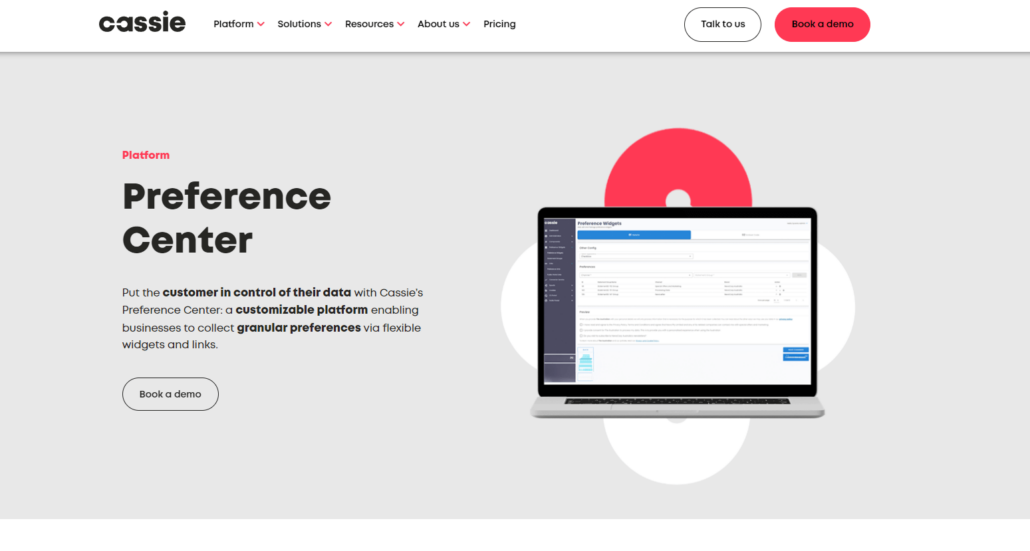
Cassie is a privacy management and consent platform developed by Syrenis. It’s advertised as an all-encompassing tool that covers consent, cookie, and preference management. The platform includes granular consent and preference capabilities.
Cassie’s advanced Preference Management Platform enables businesses to give users more control over their data. The portal is fully brandable and customizable and uses flexible widgets and links to collect granular user preferences to deliver an optimized and personalized customer experience.
Paired with the Customer Service Portal, customers’ teams will be able to ensure timely updates to customer permissions and preferences from a single source of truth.
Cassie Preference Center features
- Preference management: Empower users to manage their preferences across multiple channels and touchpoints from a single portal.
- Customer Service Portal: Quick and easy for support teams to respond to any customer preference requests on a secure customer service portal.
- API integration: Enables integration with other systems and applications via Cassie’s vast selection of APIs and helps to ensure consent and preference data can flow seamlessly across customers’ digital ecosystem in real time.
Cassie Preference Center pricing plans
Cassie offers custom pricing only on request.
| Pros | Cons |
|---|---|
| User verification via two-factor authentication and PII | Limited third-party reviews available |
| Fully brandable UI | |
| Vast API library |
8. PossibleNOW MyPreferences
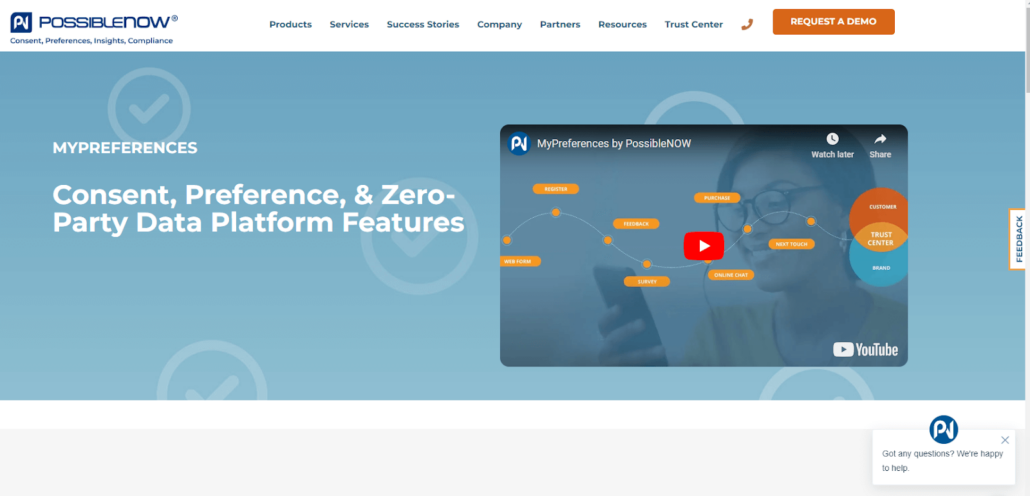
PossibleNOW specializes in preference and consent management solutions, as well as data privacy compliance and customer experience management.
PossibleNOW’s MyPreferences offering is an enterprise preference management platform that enables customers to capture, manage, and leverage customer preferences and consent across multiple channels and touchpoints.
The tool enables businesses to create multilingual and fully customizable experiences based on zero-party data. With its built-in propagation engine, MyPreferences enables customers’ stated preferences to be carried over to all contact methods.
PossibleNOW MyPreferences features
- Centralized preference management: MyPreferences provides a centralized platform for managing all customer preferences and consent, enabling customers to collect granular zero-party data to inform micro-experiences.
- Omnichannel capability: The platform supports preference collection and management across a wide range of channels, including web, email, SMS, call centers, and in-person interactions.
- Do Not Contact compliant: Integrated with a “Do Not Contact” solution to help ensure compliance with various regulations, including TCPA, CAN-SPAM, and CSL.
PossibleNOW MyPreferences pricing plans
PossibleNOW offers custom pricing only on request.
| Pros | Cons |
|---|---|
| Do Not Contact compliant | Some G2 users find the tool to be complex |
| Includes secure, agent-facing portal to manage customer preferences | |
| Suitable for scaling companies |
What is the value of combining a preference management solution with a consent management solution?
Combining preference management and consent management in a single solution offers a number of key benefits. These include:
- Easy integration: Preference and consent management solutions can be easily integrated with companies’ existing tools for websites and apps. They don’t require massive financial or resource investment or the reworking of existing systems.
- Enhances data strategy and marketing operations: With consent and preference management provided by a single platform, end users get a single touchpoint to manage their own data with companies, including consent choices for data privacy, personal contact information, communication preferences, and purchase history.
Companies can also limit the number of vendors they need to engage to achieve their business objectives, access and centralize the data they need for marketing initiatives, and enable their privacy compliance when they do so. - Better customer experience: The two solutions working together and providing data transparency make it easier for end users provide information to get the communications and interactions with companies that they want, when they want them.
These solutions demonstrate respect for end users, helping them to become more comfortable engaging with businesses, and more inclined to provide additional data and complete more purchases. They can also feel confident about their privacy being respected, as brands are transparent about data use.
Integrate preference management and consent management with Usercentrics
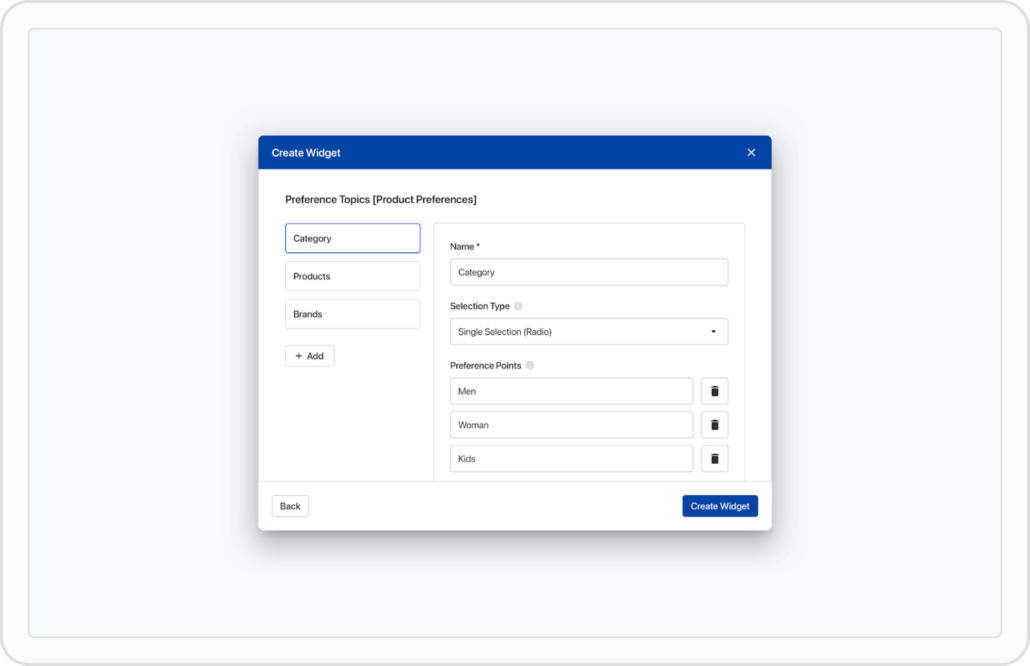
The Usercentrics Preference Manager enables you to create custom widgets to collect granular consumer data.
Preference management platforms help you balance personalization with privacy, enable compliance with data protection laws, and empower your customers to take control of their data. By giving users privacy control, these tools help to build trust and boost user engagement.
Read about email marketing laws now
Usercentrics offers a robust platform for seamlessly integrating consent and preference management. Using Usercentrics CMP and Preference Manager, you can incorporate all the user data into your Preference Management Portal. This empowers you to create a centralized preference management hub, giving users a complete view of and access to and customization ability for their consents and permissions.
With Usercentrics, your business can position itself for ongoing success in a privacy-conscious marketplace. Talk to one of our experts.
Navigating IT compliance is vital for businesses in today’s digital world. With so many business processes running on cloud-based platforms, legislators are increasingly attentive to who has access to sensitive data, how it’s handled, and which IT security measures are in place to protect it.
As a consent management platform (CMP) provider, Usercentrics keeps up to date with IT compliance requirements. After all, we provide software that helps our clients ensure these legal requirements are met.
We’ve drawn upon these insights to create this essential guide, where you’ll find the tips, standards, and insights you need to understand and navigate the complexities of IT compliance.
What is IT compliance?
IT compliance refers to the requirement for an organization’s IT systems and processes to meet security, regulatory, and contractual standards.
To meet and maintain IT compliance standards, you must ensure all your technology processes and systems, and data management strategies, align with both industry standards and the legal requirements outlined in regulations for every region where you operate.
Some regulations are also extraterritorial. They apply, for example, to the personal data of users in a specific region, and thus require your regulatory compliance if you process that data, even if your company is not located in that region.
While exact regulatory requirements can vary, the overarching goal is typically to protect the data and privacy of customers and employees, and to maintain data integrity and security across the board.
Why is IT compliance important?
“IT compliance means following the rules and regulations related to technology and data. It involves making sure that a company’s systems and processes meet legal requirements and industry standards.
This could include things like protecting customer information, keeping systems secure from hackers, and following guidelines for how data is stored and used.
In Usercentrics, as a certified ISO27001 and TISAX company, we have implemented all the possible arsenal of required concepts, controls, and policies to ensure that all the scopes are covered and controlled in the most efficient way.”
— Ludovic L’Hoir, Usercentrics Sr. Manager IT Operations & IT Compliance
While compliance requires ongoing work and investment, its benefits far outweigh the costs, and mitigate risks. Here’s why achieving and maintaining IT compliance is so important:
- Legal and regulatory compliance reduces the risk of fines, other legal penalties, and loss of brand reputation.
- Robust compliance standards enhance data security, safeguard against data breaches, and protect sensitive information.
- Communicating compliance status builds and maintains consumer trust.
- Evolving legislation is a helpful benchmark to ensure your IT systems and strategies are resilient and up to current standards.
IT compliance vs IT security
IT compliance focuses on ensuring that an organization’s IT systems and practices meet legal and regulatory standards, often involving policies, procedures, and documentation to prove adherence.
IT security, however, is more technical and practical, concentrating on protecting IT systems, data, and networks from cyber threats, unauthorized access, and data breaches. While IT compliance is about meeting specific standards set by external bodies, IT security is about actively defending against threats and vulnerabilities.
“IT compliance is about following rules and regulations, like laws and industry standards, to make sure everything is legal and meets requirements. It’s like making sure you’re following the speed limit while driving.
On the other hand, IT security is about protecting computer systems and data from being hacked or accessed by unauthorized people. It’s like locking your doors at home to keep burglars out.
So, while IT compliance focuses on following the rules, IT security focuses on keeping everything safe from potential threats. They’re related because security measures are part of IT compliance, but they’re not the same thing.
Compliance is about meeting specific guidelines, while security is about protecting against potential dangers.
In Usercentrics as a certified ISO27001 and TISAX company we have implemented specific concepts and controls related to IT security, including but not limited to regular pentests, encryptions, and security through EDR.” — Ludovic L’Hoir, Usercentrics Sr. Manager IT Operations & IT Compliance
Do you need to worry about IT compliance?
From mobile gaming to financial services, if your organization uses digital technologies and manages data, regardless of size or industry, then you need to be concerned about IT compliance.
That said, the degree and complexity of legal requirements will depend on the sector and type of organization. For instance, if your company deals with critical infrastructure — like energy, transport, and water supply — the stakes of compliance are especially high, so your requirements will be uniquely strict and complex.
“IT compliance is important for any business that deals with sensitive data, no matter what they do or how big they are. By following these rules, companies protect people’s information, follow the law, and earn the trust of customers and others who rely on them,” says Ludovic L’Hoir, Usercentrics Sr. Manager IT Operations & IT Compliance.
“For example, companies like Usercentrics, which work with people’s data, follow rules like GDPR, ISO27001, and TISAX to show customers they take data security seriously and can be trusted.”
But even the smallest startups aren’t exempt from the watchful eye of regulators and must navigate laws and industry standards to ensure data protection, security, and integrity within their IT systems and processes.
“Compliance helps prevent problems like data breaches, protects people’s privacy, and avoids legal trouble,” L’Hoir states.
IT compliance regulations
To navigate IT compliance effectively, businesses need to stay up to date with all rules and regulations that apply to the regions where their customers and employees are based, as well as relevant business practices. Some key laws include:
- The General Data Protection Regulation (GDPR): Defines privacy rights and mandatory data protection measures for individuals residing in the European Union and European Economic Area. Affects organizations worldwide if they handle EU residents’ data.
- The HIPAA (Health Insurance Portability and Accountability Act): This is a federal law in the United States that protects sensitive patient data, requiring healthcare providers and their third-party vendors to safeguard this information and prevent nonconsensual disclosure.
- The California Consumer Privacy Act (CCPA): Provides privacy rights to California residents, including the right to know about the personal information collected about them and how it’s used. This was significantly amended and expanded with the California Privacy Rights Act (CPRA) in January 2023.
- The Transparency and Consent Framework (TCF 2.2): Developed by the Interactive Advertising Bureau Europe, this framework standardizes how publishers and advertisers can manage consumer consent for data collection and usage across Europe.
- The Payment Card Industry Data Security Standard (PCI DSS): Applies globally to any organization that handles credit card information, this standard demands strict data security measures to protect cardholder data.

Top tip: Check if your mobile app is compliant with the Usercentrics Mobile Apps SDK.
Minimize legal risk with a consent management platform (CMP)
A lot goes into ensuring IT compliance. Usercentrics CMP streamlines processes by ensuring your digital properties meet key legal requirements. More specifically, the CMP makes it easy to obtain, securely store, manage, and signal valid user consent in line with legal standards in the GDPR and CCPA/CPRA, among other regulations, and business requirements from large digital platforms.
By automating various processes related to user consent, you can rest assured that all potential gaps and blind spots are covered — without having to deal with the significant time and resource requirements to manually ensure compliance.
Usercentrics CMP has an extensive feature set that enables customization of your implementation to the legal context of your business, industry, and geography.
It also integrates with many popular web platforms and marketing tools that handle functions from analytics to retargeting. And it works with your tech stack to protect data and boost marketing performance, enhancing campaigns with personalization and other features while following best practices for data security.
U.S. compliance deep dive: Learn more about U.S. state-level data privacy laws
How Usercentrics prioritizes IT compliance
Usercentrics prioritizes IT compliance through comprehensive data management and security measures.
- Data types and processing purposes: Usercentrics CMP enables companies to notify users about and obtain consent for personal data collection and processing via cookies and other tracking technologies at a granular level. This can include everything from account activity to IP address to contact information. Users can grant or deny consent to their preferred degree of granularity and easily change or revoke it at any time, in compliance with consent requirements of various international data privacy laws.
- Data ownership: The customer retains ownership of their data, with permissions for its collection and use clearly defined. In the event of a data subject access request, Usercentrics provides the user with a copy of their consent-related data, which is also theirs. Usercentrics’ Terms & Conditions lay out the contractual terms of our access to data, among other stipulations.
- How customers retrieve their data: Customers can make a data subject access request via the contact details and method outlined in our Privacy Policy. Any data requested is securely delivered only to the authorized and verified user.
- Data deletion timeline: Data is automatically deleted after a 12-month retention period. The consent data collected by a company is also deleted if their account is terminated. Backup files are encrypted.
- Controlled data access: Customers ultimately control who has access to their data online, and Usercentrics CMP helps to facilitate those permissions for data processing on websites, apps, and other connected platforms.
- Login authentication: Authentication is always performed via username and password, with optional two-factor authentication available on request. The two variants for the login authentication are a federated login via Google, or via the Auth0 authentication service.
- Data transmission and encryption: Data is transferred using HTTPS encryption (TLS 1.3). Data in idle mode is encrypted using AES256, with different codes used for each respective data packet.
- Data separation and storage: A customer-specific Settings ID logically separates data between unique customers in the database. Data from different categories is stored in separate databases with individual access keys.
- Service interruption protocol: Usercentrics has multi-stage recovery processes for service interruptions, with alert systems that ensure rapid response from our technical team.
Achieving and maintaining IT compliance is a non-negotiable. If your business handles user data, you must ensure your technology processes and systems are up to current standards, and are compliant with international regulatory standards.
Despite the many regulations, technologies, and cyber threats that impact IT compliance, your business can set itself up for success — by using the right tools and technologies.
Usercentrics prioritizes IT compliance through comprehensive data management and security measures. From granular consent management to controlled data access and encryption, our software helps you ensure IT compliance. Speak to a Usercentrics expert today.
Google has announced changes related to the new signals introduced to Google Consent Mode. Since a significant portion of our customers and partners use Google products, these changes are important for Usercentrics CMP and that’s why we’re proud to release Google Consent Mode V2 support on our platform.
What is Google Consent Mode?
If this is your first time hearing about Google Consent Mode, it’s a tool that includes APIs that allow businesses to modify how Google tags function based on user consent decisions related to ads and analytics cookies.
Previously, Google Consent Mode was primarily recognized for its anonymized tracking of data without consent. The role of Consent Mode has since evolved and it now primarily functions as a signaling tool.
Why is Google Consent Mode important?
Using Google Consent Mode provides you a distinct competitive edge. Why? While compliance with the General Data Protection Regulation (GDPR) is crucial, it’s more of an obligation than a perk.
If you’re using Google Analytics, Google Tag Manager or Google Ads, Google Consent Mode helps you both optimize opt-in rates and gain conversion insights for those users who do not provide consent. As a website operator, this means you get over 70 percent of data back for advertisers.
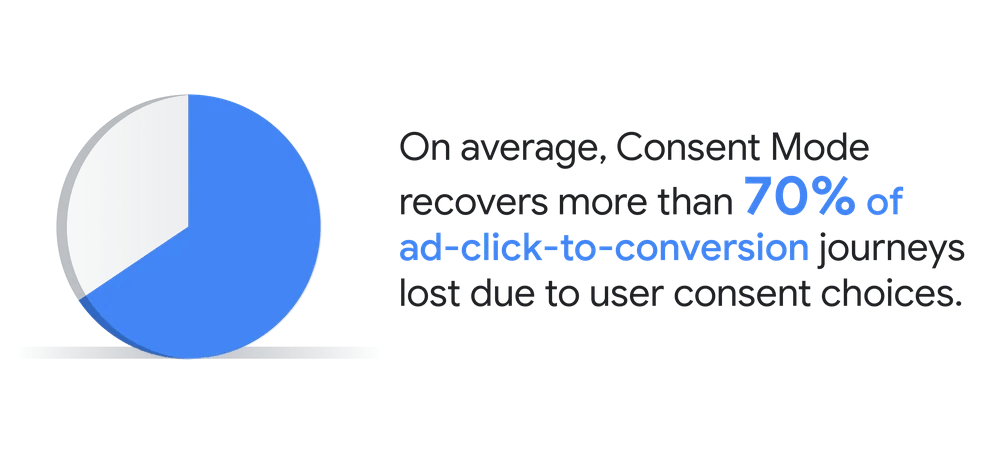
Source: Google Marketing Platform Blog
What are the upcoming changes with Google Consent Mode V2?
The new Google Consent Mode key settings are ad_user_data and ad_personalization.
The two new key settings are set based on the same trigger as ad_storage.
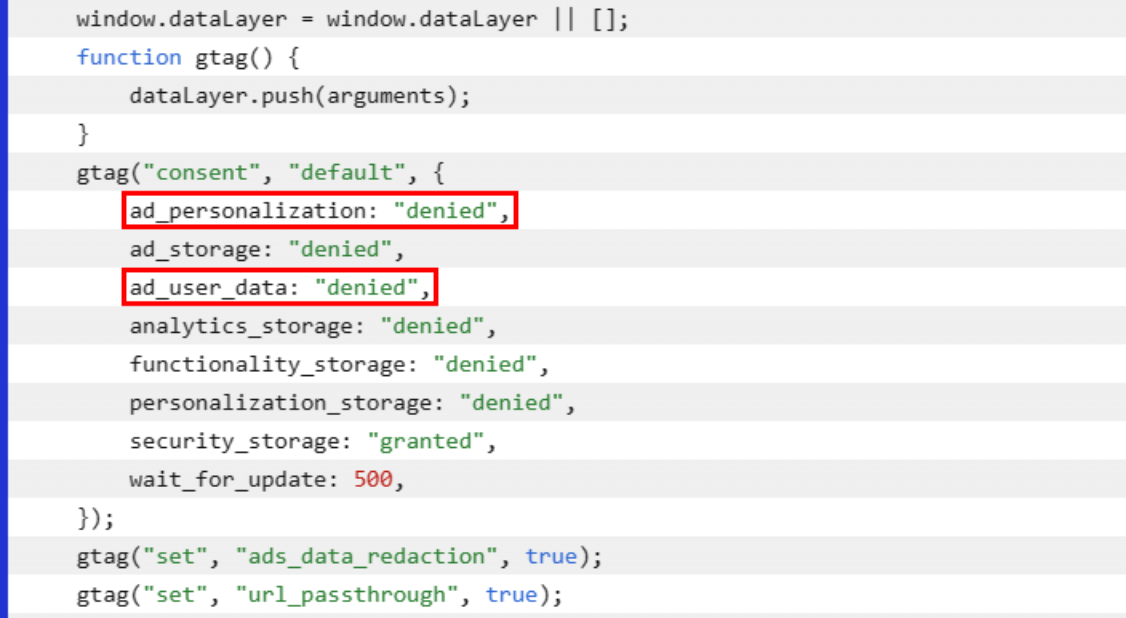
Google Consent Mode settings
What is the ad_user_data Google Consent Mode setting?
Google Consent Mode ad_user_data setting controls whether personal data is sent to a Google core platform service such as Google Ads, Google Shopping and Google Play.
- ad_user_data consent state has two values – granted or denied. These map to user choices.
- Example: Ad_user_data is set to granted when the user affirmatively consents to their data being shared with Google once they have indicated that choice by interacting with a banner.
What is the ad_personalization Google Consent Mode setting?
Google Consent Mode ad_personalization setting controls whether data can be used for ads personalization (e.g. remarketing).
- ad_personalization has two values – granted or denied. These map to user choices.
- Example: Ad_personalization is set to granted when the user has affirmatively consented to their data being shared with Google for the purposes of ad personalization once they have indicated that choice by interacting with a banner.
How does Usercentrics web and app CMP adapt to Google Consent Mode V2?
To align with the changes of Google Consent Mode v2 and to guarantee that our customers have the necessary Consent Mode signaling, we support the Consent Mode v2 to ensure that user consent for the two new attributes are correctly signaled to Google.
We recommend all Usercentrics CMP customers to activate Google Consent Mode v2 to ensure that user consent is passed to Google and can continue undisrupted usage of Google advertising, measurement and personalization features.
Consent management with Google Consent Mode v2: what actions do you need to take?
If you already have Google Consent Mode implemented or you are planning to activate Google Consent Mode v2, please review our Usercentrics CMP Google Consent Mode support guide.
For new customers, Google Consent Mode v2 is enabled by default.
Google Consent Mode: Questions & Answers
Find out about more about Google’s announced changes with our Google’s Consent Mode FAQs below.
What are the changes to Google Consent Mode?
With Consent Mode v2, Google has added two new signals to their framework: ad_user_data and ad_personalization. These are crucial for ensuring compatibility with Google’s evolving requirements, especially in regards to the upcoming changes with the Digital Markets Act.
- ad_user_data: controls whether personal data is sent to a Google core platform service
- ad_personalization: controls whether data can be used for ads personalization (eg. remarketing)
Why are these changes happening?
We want to ensure that all our customers using Google products have a seamless integration with our standard CMP implementation.
What type of Google Consent Mode implementation can be used?
The additional Google Consent Mode parameters can be implemented via:
- Google Tag Manager template
- Directly into your website code
- Consent Mode default will be also signaled by our TCF implementation
What implementation type would you recommend?
Our general recommendation is to manually implement the consent script for optimal integration. However, if you decide against this manual implementation, rest assured our changes will ensure compatibility on your behalf.
How can I check if Consent Mode is implemented correctly?
Follow the steps listed in our Google Consent Mode documentation.
How do the changes impact Usercentrics partners?
If you’re communicating with Usercentrics customers, please ensure that they are informed and that the Consent Mode signals are implemented correctly. This is especially important if these customers use any Google services.
We are thrilled to introduce this highly requested scanner feature, aimed at simplifying the setup of the CMP within mobile apps. In response to feedback from our valued Mobile Apps customers, we have made two significant updates that will greatly enhance your operational efficiency.
Third-party Technology Scanner for Apps
Working very closely with App developers, we listened to their pains and learned about the complexities involved in setting up a compliant legal banner for mobile applications. The new automated SDK scanner will enable any team member to effortlessly identify third-party technologies installed in your mobile application, streamlining the configuration process of the banner.
By automating a substantial part of the App CMP setup, we are committed to providing you with a smoother learning curve and increased confidence when adopting our platform. Our goal is to make privacy compliance easy for you, allowing you to focus on your core business while our technology handles the rest. Once technologies are identified, the scanner also provides a suggested categorization for each technology (e.g., marketing, essential, functional).
Compliance should not be complicated. We are confident these changes will reduce your setup time, increase accuracy, and ultimately add more value to your business.
We can’t wait for you to try out these new features, and as always, we look forward to your feedback. For any queries or support, please reach out to our team.
And if you are not a customer yet, or if you are not sure if you need a CMP for your application, you can start a free trial to learn more about our features.
We are pleased to announce that Usercentrics CMP has been certified by Google. As per Google’s announcement on 16th May, publishers using Google AdSense, Ad Manager, or AdMob products for serving ads in the EEA and UK will be required to use only Google-certified Consent Management Platforms (CMPs).
Google’s main objective with this requirement is to establish “a more unified and reliable approach to transparency and consent” and “a more privacy-conscious digital advertising ecosystem.”
Usercentrics has always been at the forefront of digital data privacy compliance and has worked closely with Google. The Usercentrics CMP was among the first certified CMPs when Google launched its CMP Partner Program for Google Consent Mode in September 2022.
We are honored that both our products – Usercentrics CMP and Cookiebot CMP – are included in Google’s list of certified CMPs.
How can publishers comply with Google’s new CMP requirements?
If you’re already a Usercentrics customer, there is no action needed from you for now. Rest assured that you are meeting Google’s new requirements.
If you’re a publisher who has not yet implemented a consent management platform, or if your current CMP provider is neither certified nor has plans to become certified, this is your chance to fully capitalize on the benefits offered by Usercentrics CMP for your business and optimize your monetization efforts.
We are excited to continue strengthening our collaboration with both Google and publishers. For any questions or concerns, book a quick meeting with one of our experts.
Contact salesWe have gathered all information on the scope of services of the Usercentrics Consent Management Platform (CMP) in an RFI.
Download the template free of charge now!
